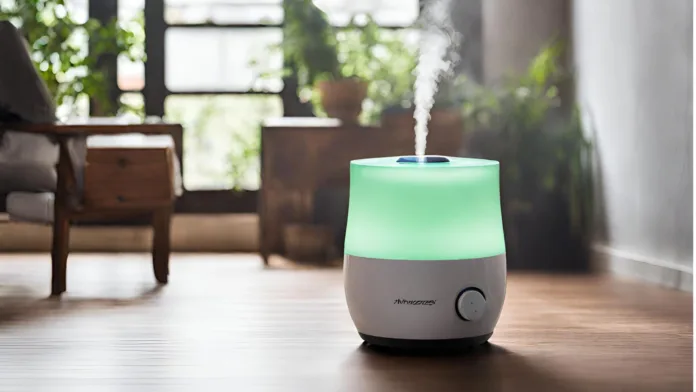Air quality is one of the most important aspects of our lives. While we often think of polluted air as being outside, it’s important to remember that the air inside our homes can also be full of harmful pollutants and allergens. In fact, according to the Environmental Protection Agency (EPA), indoor air pollution levels can be 2 to 5 times higher than outdoor levels. This is why it is essential to take steps to improve the air quality in our homes.
One of the most effective ways to improve air quality is by using an air humidifier. Air humidifiers add moisture to the air, which can help eliminate many common issues associated with dry air, such as dry skin, sinus congestion, and allergies. In this article, we’ll take a closer look at how air humidifiers work and how they can help increase air quality in your home.
What is an Air Humidifier?
An air humidifier is a device that adds moisture to the air in a room. It works by releasing water droplets into the air, which then evaporate and increase the humidity levels. Most air humidifiers come with a water tank and a filter that removes impurities from the water before releasing it into the air. There are several types of air humidifiers available in the market, such as warm-mist, cool-mist, evaporative, and ultrasonic humidifiers. Each type has its unique method of adding moisture to the air, but they all have the same goal of increasing humidity levels and improving air quality.
How Does an Air Humidifier Increase Air Quality?
The main function of an air humidifier is to increase the humidity levels in a room. The ideal humidity level for a home is between 30-50%. When the humidity level drops below 30%, the air becomes too dry, leading to a range of issues such as dry skin, chapped lips, and respiratory problems. An air humidifier helps to balance the humidity levels in a room, making the air more comfortable to breathe in. Here are some ways that an air humidifier can increase air quality in your home:
- Reduces Dry Air
Dry air can lead to a range of health problems, especially for people with respiratory issues. Low humidity levels can dry out mucus membranes, making it easier for bacteria and viruses to enter your body. An air humidifier adds moisture to the air, which helps to keep the airways moist and prevents respiratory issues like coughs and colds.
- Relieves Allergy Symptoms
Indoor allergens such as dust, pollen, and pet dander can be a nightmare for people with allergies. These allergens can easily infiltrate our homes, causing flare-ups and making it difficult to breathe. By increasing the humidity levels in a room, an air humidifier can help to reduce the concentration of these allergens, making it easier for allergy sufferers to breathe.
- Soothes Dry Skin
Dry air can also have a negative impact on our skin, causing dryness and irritation. Using an air humidifier can restore moisture to the air, which can help to keep your skin hydrated and healthy. This is especially beneficial during the winter months when the air is drier.
- Prevents Static Electricity
During dry weather, static electricity can become a major nuisance. It can cause your hair to stand up, give you small electric shocks, and cling your clothes. An air humidifier helps to balance the air’s moisture levels, making it less dry and reducing the occurrence of static electricity.
- Improves Sleep Quality
Dry air can also disrupt your sleep, leading to a range of issues such as snoring, coughing, and a blocked nose. Adding moisture to the air with an air humidifier can help to prevent these problems, promoting a good night’s sleep and overall better health.
Tips for Using an Air Humidifier
Now that we understand the benefits of using an air humidifier to improve air quality, here are some tips for using it effectively:
- Choose the Right Type
As mentioned before, there are different types of air humidifiers available in the market. It’s important to choose the one that best suits your needs and the size of the room. Warm-mist humidifiers are best for smaller rooms, cool-mist and ultrasonic humidifiers are suitable for larger rooms, and evaporative humidifiers are ideal for bedrooms. It’s also essential to choose one with a sizeable water tank so that you don’t have to refill it frequently.
- Clean the Humidifier Regularly
To prevent bacteria and mold growth, it’s crucial to clean your air humidifier regularly. Water in the tank can become a breeding ground for these harmful organisms, so be sure to follow the manufacturer’s instructions for cleaning and maintenance.
- Keep the Humidity Level in Check
While humidity is essential for good air quality, excessive humidity can cause other problems like mold growth and dust mites. It’s crucial to monitor the humidity levels in your home and adjust the humidifier’s settings accordingly.
- Use Distilled Water
To avoid releasing impurities into the air, it’s best to use distilled water in your humidifier. This is especially important if you have hard water in your area, as it can cause mineral deposits to build-up in the humidifier.
Conclusion
In conclusion, air humidifiers are an excellent tool for improving indoor air quality. They add moisture to the air, which can help to reduce a range of issues caused by dry air, such as respiratory problems, allergies, and dry skin. However, it’s essential to choose the right type of humidifier for your needs and to clean and maintain it regularly. By following these tips, you can effectively use an air humidifier to increase air quality in your home and promote better health and well-being for you and your family.

